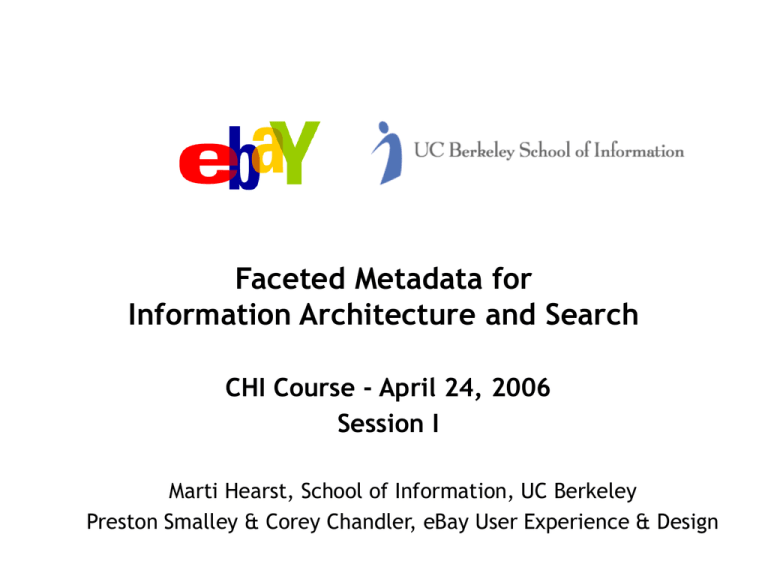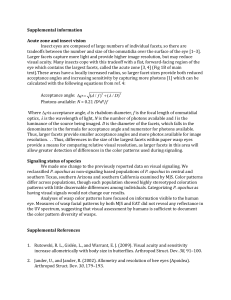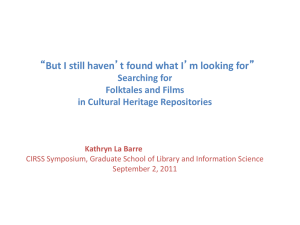Faceted Metadata for Information Architecture and Search
advertisement

Faceted Metadata for Information Architecture and Search CHI Course - April 24, 2006 Session I Marti Hearst, School of Information, UC Berkeley Preston Smalley & Corey Chandler, eBay User Experience & Design Session I: Agenda Intro and Goals (5 min) Faceted Metadata (15 min) Definition Advantages Interface Design using Faceted Metadata (40 min) The Chess Analogy The Nobel Prize Example Results of Usability Studies Software Tools Design Issues (15 min) Q&A (15 min) 2 Focus: Search and Navigation of Large Collections Shopping Sites Digital Libraries E-Government Sites Image Collections 3 Problems with Site Search Study by Vividence in 2001 on 69 Sites 70% eCommerce 31% Service 21% Content 2% Community Poorly organized search results Frustration and wasted time Poor information architecture Confusion Dead ends "back and forthing" Forced to search 4 What we want to Achieve Integrate browsing and searching seamlessly Support exploration and learning Avoid dead-ends, “pogo’ing”, and “lostness” 5 Main Idea Use hierarchical faceted metadata Design the interface to: Allow flexible navigation Provide previews of next steps Organize results in a meaningful way Support both expanding and refining the search 6 The Problem With Categories Most things can be classified in more than one way. Most organizational systems do not handle this well. Example: Animal Classification robin penguin otter penguin robin salmon wolf cobra bat robin bat robin bat salmon salmon cobra wolf wolf cobra bat otter wolf penguin otter, seal salmon otter penguin seal Skin Covering Locomotion Diet 7 The Problem with Hierarchy Inflexible Force the user to start with a particular category What if I don’t know the animal’s diet, but the interface makes me start with that category? Wasteful Have to repeat combinations of categories Makes for extra clicking and extra coding Difficult to modify To add a new category type, must duplicate it everywhere or change things everywhere 8 The Problem With Hierarchy start swim fur fly scales feathers fur run scales feathers fur scales slither … feathers fish fish fish fish fish fish fish fish fish rodents rodents rodents rodents rodents rodents rodents rodents rodents insects insects insects salmon insects bat insects insects robin insects insects insects wolf 9 The Idea of Facets Facets are a way of labeling data A kind of Metadata (data about data) Can be thought of as properties of items Facets vs. Categories Items are placed INTO a category system Multiple facet labels are ASSIGNED TO items 10 The Idea of Facets Create INDEPENDENT categories (facets) Each facet has labels (sometimes arranged in a hierarchy) Assign labels from the facets to every item Example: recipe collection Ingredient Cooking Method Chicken Stir-fry Bell Pepper Curry Course Cuisine Main Course Thai 11 The Idea of Facets Break out all the important concepts into their own facets Sometimes the facets are hierarchical Assign labels to items from any level of the hierarchy Preparation Method Fry Saute Boil Bake Broil Freeze Desserts Cakes Cookies Dairy Ice Cream Sorbet Flan Fruits Cherries Berries Blueberries Strawberries Bananas Pineapple 12 Using Facets Now there are multiple ways to get to each item Preparation Method Fry Saute Boil Bake Broil Freeze Fruit > Pineapple Dessert > Cake Preparation > Bake Desserts Cakes Cookies Dairy Ice Cream Sherbet Flan Fruits Cherries Berries Blueberries Strawberries Bananas Pineapple Dessert > Dairy > Sherbet Fruit > Berries > Strawberries Preparation > Freeze 13 Using Facets The system only shows the labels that correspond to the current set of items Start with all items and all facets The user then selects a label within a facet This reduces the set of items (only those that have been assigned to the subcategory label are displayed) This also eliminates some subcategories from the view. 14 The Advantage of Facets Lets the user decide how to start, and how to explore and group. 15 The Advantage of Facets After refinement, categories that are not relevant to the current results disappear. Note that other diet choices have disappeared 16 The Advantage of Facets Seamlessly integrates keyword search with the organizational structure. 17 The Advantage of Facets Very easy to expand out (loosen constraints) Very easy to build up complex queries. 18 Advantages of Facets Can’t end up with empty results sets (except with keyword search) Helps avoid feelings of being lost. Easier to explore the collection. Helps users infer what kinds of things are in the collection. Evokes a feeling of “browsing the shelves” Is preferred over standard search for collection browsing in usability studies. (Interface must be designed properly) 19 Advantages of Facets Seamless to add new facets and subcategories Seamless to add new items. Helps with “categorization wars” Don’t have to agree exactly where to place something Interaction can be implemented using a standard relational database. May be easier for automatic categorization 20 Information previews Use the metadata to show where to go next More flexible than canned hyperlinks Less complex than full search Help users see and return to previous steps Reduces mental work Recognition over recall Suggests alternatives More clicks are ok only if (J. Spool) The “scent” of the target does not weaken If users feel they are going towards, rather than away, from their target. 21 Facets vs. Hierarchy Early Flamenco studies compared allowing multiple hierarchical facets vs. just one facet. Multiple facets was preferred and more successful. 22 Limitation of Facets Do not naturally capture MAIN THEMES Facets do not show RELATIONS explicitly Aquamarine Red Orange Door Doorway Wall Which color associated with which object? Photo by J. Hearst, jhearst.typepad.com 23 Terminology Clarification Facets vs. Attributes Facets are shown independently in the interface Attributes just associated with individual items E.g., ID number, Source, Affiliation However, can always convert an attribute to a facet Facets vs. Labels Labels are the names used within facets These are organized into subhierarchies Synonyms There should be alternate names for the category labels Currently (in Flamenco) this is done with subcategories E.g., Deer has subcategories “stag”, “fawn”, “doe” 24 The Chess Analogy 25 Analogy: Chess Chess is characterized by a few simple rules that disguise an infinitely complex game The three-part structure of play Openings: many strategies, entire books on this Endgame: well-defined, well-understood Middlegame: nebulous, hard to describe Our thought: information navigation has a similar structure, and the middlegame is critically underserved. 26 The Opening Usually exposes toplevel hierarchy or top-level facets Usually also has a search component 27 The Endgame – Penultimate Pages 28 The Endgame – Content Pages 29 The Middlegame The heart of the navigation experience There is a strategic advantage to having a good middlegame Standard Web search doesn’t handle this well This is where the flexible faceted metadata approach can work best. 30 Example: Nobel Prize Winners Collection (Before and After Facets) 31 Only One Way to View Laureates 32 First, Choose Prize Type 33 Next, view the list! The user must first choose an Award type (literature), then browse through the laureates in chronological order. No choice is given to, say organize by year and then award, or by country, then decade, then award, etc. 34 Using Hierarchical Faceted Metadata 35 Opening View Select literature from PRIZE facet 36 Group results by YEAR facet 37 Select 1920’s from YEAR facet 38 Current query is PRIZE > literature AND YEAR: 1920’s. Now remove PRIZE > literature 39 Now Group By YEAR > 1920’s 40 Hierarchy Traversal: Group By YEAR > 1920’s, and drill down to 1921 41 Select an individual item 42 Use Endgame to expand out 43 Use Endgame to expand out 44 Or use “More like this” to find similar items 45 Start a new search using keyword “California” 46 Note that category structure remains after the keyword search 47 The query is now a keyword ANDed with a facet subhierarchy 48 The Challenges Users generally do not adopt new search interfaces How to show a lot more information without overwhelming or confusing? Most users prefer simplicity unless complexity really makes a difference Small details matter Next we describe the design decisions that we have found lead to success. 49 Usability Study Results 50 Search Usability Design Goals 1. 2. 3. 4. 5. 6. 7. 8. Strive for Consistency Provide Shortcuts Offer Informative Feedback Design for Closure Provide Simple Error Handling Permit Easy Reversal of Actions Support User Control Reduce Short-term Memory Load From Shneiderman, Byrd, & Croft, Clarifying Search, DLIB Magazine, Jan 1997. www.dlib.org 51 Usability Studies Usability studies done on 3 collections: Recipes (epicurious): 13,000 items Architecture Images: 40,000 items Fine Arts Images: 35,000 items Conclusions: Users like and are successful with the dynamic faceted hierarchical metadata, especially for browsing tasks Very positive results, in contrast with studies on earlier iterations. 52 Most Recent Usability Study Participants & Collection 32 Art History Students ~35,000 images from SF Fine Arts Museum Study Design Within-subjects Each participant sees both interfaces Balanced in terms of order and tasks Participants assess each interface after use Afterwards they compare them directly Data recorded in behavior logs, server logs, paper-surveys; one or two experienced testers at each trial. Used 9 point Likert scales. Session took about 1.5 hours; pay was $15/hour 53 The Baseline System Floogle (takes the best of the existing keywordbased image search systems) 54 55 56 Post-Interface Assessments All significant at p<.05 except “simple” and “overwhelming” 57 Post-Test Comparison Which Interface Preferable For: Find images of roses Find all works from a given period Find pictures by 2 artists in same media Overall Assessment More useful for your tasks Easiest to use Most flexible More likely to result in dead ends Helped you learn more Overall preference Baseline Faceted 15 16 2 30 1 29 4 28 8 23 6 24 28 3 1 31 2 29 58 Software Tools 59 Flamenco (flamenco.berkeley.edu) Demos, papers, talks are online Nobel example uses this toolkit Open source software is now available! Requires Apache and a DBMS (MySQL) You format your data in simple text files (We may add XFML support later) Our programs convert to appropriate DBMS tables Check it out: http://flamenco.berkeley.edu 60 FacetMap (facetmap.com) 61 Commercial Implementations (Not an exhaustive list) endeca.com siderean.com www.dieselpoint.com www.rawsugar.com 62 Design Issues 63 Small Details Matter With text, it’s very difficult to avoid a cluttered look Must carefully design visual details White space Font style and weight contrast Color that distinguishes and doesn’t clash BEFORE AFTER 64 “Breadcrumb” Design Chains should only be used within hierarchy Need to separate the facets This allows both expanding within a facet and removing one facet while retaining the rest of the navigation. incorrect correct 65 Checkboxes vs. Hyperlinks People LOVE checkboxes in principle However, they are dangerous because, when ANDED, they lead to empty results which people HATE They also often have confusing semantics Combine AND, OR, keyword search, etc. See Advanced Search at eat.epicurious.com 66 Checkboxes vs. Hyperlinks (Advanced search from epicurious.com) 67 Handling Disjunction (ORs) The faceted queries are really a combination of ANDs and ORs The facet hierarchies actually do this Example: select Animal > Feline AND Location >Continent > North America This actually does a query as follows: AND( OR (panther, jaguar, lion), OR (US, Canada, Mexico) ) Nevertheless, sometimes you want to select just a subset of a facet’s labels 68 Handling Disjunction (ORs) Using checkboxes with ORs can work However, if allowed everywhere they clutter the screen eBay shows how to do it: Focus on one facet Select multiple labels Treat as an OR Won’t get empty results 69 How many facets? Many facets means more choice, but more scanning and more scrolling An alternative (by eBay) initially show the few most important facets allow user to choose a label from one then show an additional new facet (next most important) The right choice depends on the application Browsing art history vs. shopping 70 Revealing Hierarchy One approach (Flamenco): keep all facets present, show deeper level as you descend. 71 Revealing Hierarchy Another approach (eBay): show only one level at a time; if a facet is chosen that has subhierarchy, show the next level as an additional facet. Example: In Shoes, user selects Style > Athletic Now show a new facet that shows types of Athletic shoes Hiking, Running, Walking, etc. 72 Reversibility Make navigation urls consistent and persistent This way the Back button always works Allows for bookmarking of pages 73 Choosing Labels Labels must be short – to fit! Tricky with terminology: “endoplasmic reticulum” Labels must be evocative It’s very difficult to find successful words Depends on user familiarity with the domain Use card-sorting exercises Associate synonyms with labels Beware the context of label use! The “kosher salt” incident 74 Creating Facets Need to balance depth and breadth Avoid long “skinny” hierarchies Example from the Art and Architecture Thesaurus: 7 clicks before you get to anything interesting 75 Summary Flexible application of hierarchical faceted metadata is a proven approach for navigating large information collections. Midway in complexity between simple hierarchies and deep knowledge representation. Currently in use on e-commerce sites; spreading to other domains We have presented design issues and principles. 76 Session II: Agenda Highlights from Session 1 (5 min) Interactive exercise (20 min) Evolution of IA at eBay (10 min) Demo of latest eBay design (5 min) Lessons learned at eBay (35 min) Discussion and Q&A (15 min) 77 Discussion 78 Faceted Metadata for Information Architecture and Search CHI Course - April 24, 2006 Session II Marti Hearst, School of Information, UC Berkeley Preston Smalley & Corey Chandler, eBay User Experience & Design Session II: Agenda Highlights from Session 1 (5 min) Interactive exercise (20 min) Evolution of IA at eBay (10 min) Demo of latest eBay design (5 min) Lessons learned at eBay (35 min) Discussion and Q&A (15 min) 80 Highlights from Session I 81 Terminology Clarification Facets vs. Attributes Facets are shown independently in the interface Attributes just associated with individual items E.g., ID number, Source, Affiliation However, can always convert an attribute to a facet Facets vs. Labels Labels are the names used within facets These are organized into subhierarchies Synonyms There should be alternate names for the category labels Currently (in Flamenco) this is done with subcategories E.g., Deer has subcategories “stag”, “fawn”, “doe” 82 Interactive Exercise Introduce yourself to 4-6 people near you that you don’t already know Exchange business cards and note: Region they live (e.g. Canada, Western Europe) Role (e.g. Information Architect, User Researcher) Number of years of experience 83 Interactive Exercise Organize the business cards using a hierarchy assuming you are a talent recruiter in Montreal 84 Interactive Exercise: One way… start NA IA 10+ EU Mgr Programmer 10+ 4-9 1-4 10+ 4-9 1-4 IA Mgr Programmer 10+ 4-9 1-4 Business Card #1 Asia 10+ 4-9 1-4 Business Card #2 10+ 4-9 1-4 IA 1-4 Business Card #3 … Mgr Programmer 10+ 4-9 … 10+ 4-9 1-4 10+ 4-9 1-4 4-9 1-4 Business Card #4 85 Evolution of IA at eBay Flat Structure (2000 and earlier) Clothing, Shoes & Accessories Shoes Women’s Shoes - Boots - Pumps - Sandals 86 Evolution of IA at eBay Flat Structure Issues with approach: (2000 and earlier) Products had to be categorized in just one way. Clothing, Shoes & Accessories Shoes Women’s Shoes - Boots - Pumps - Sandals Ex: Where are all the red Women’s shoes? Adding more descriptors meant creating a deep and complicated category structure. Ex: Shoes > Women’s > Boots > Black > Size 8 87 Evolution of IA at eBay + Product Facets (2001 – 2005) Clothing, Shoes & Accessories Shoes Women’s Shoes - Style (Boots, Pumps, Sandals…) - Size (6, 6.5, 7, 7.5…) - Color (Black, Red, Tan…) - Condition (New, Used…) Added Facets (flat) 88 Evolution of IA at eBay + Product Facets Issues with approach: (2001 – 2005) Encourages over-constrained queries (Values “ANDED” together) Clothing, Shoes & Accessories Shoes Women’s Shoes - Style (Boots, Pumps, Sandals…) - Size (6, 6.5, 7, 7.5…) - Color (Black, Red, Tan…) - Condition (New, Used…) Placing facets behind dropdowns reduces the exposure of the values to the user Left-Navigation Placement is only used a minority of the time by users While effective within a product domain their still is a need for facets above that level Ex: Everything Coach makes that is Red. 89 Evolution of IA at eBay Faceted Metadata (May 2005 Magellan Test) Clothing, Shoes & Accessories Shoes Women’s Shoes - Style (Boots, Pumps, Sandals…) - Size (6, 6.5, 7, 7.5…) - Color (Black, Red, Tan…) - Condition (New, Used…) - Brand (Nine West, Coach…) Brands Coach Louis Vuitton Materials Cotton Leather Moved to a Top Positioned Link Structure Added Hierarchical Facets 90 Matching items 91 Matching items 92 Matching items 93 Matching items 94 Matching items 95 Matching items 96 Matching items 97 Matching items 98 Matching items 99 Matching items 100 Matching items 101 Matching items 102 Matching items 103 Matching items 104 Matching items 105 Latest eBay design is now live! Try multi-faceted search yourself with the launch of eBay Express in Spring 2006. See http://express.ebay.com for details. 106 Methodology Qualitative: Rapid Iterative Testing & Evaluation (RITE) Method (2 days testing, 1 day to iterate design) n = 48 users (over 9 months) 10 versions of the design 3 domains: Shoes, TVs, and Collective Glass Quantitative: A/B Test on the live site for 3 weeks [n = 73k searches in test environment compared to current site] 107 Lessons Learned at eBay Data Design Facets Flexibility of Facets vs. Hierarchy Dependencies Presentation Integrating “browse” and “search” Control Placement Facet Presentation Breadcrumbs 108 Facets Lesson: Users desire facets above the domain Users also want… Brands (Coach, Louis Vuitton) Materials (Leather, Cotton) 109 Flexibility of Facets vs. Hierarchy Lesson: Users expect multiple entry points into a domain (tickets under sports) Tickets? 110 Dependencies Lesson: Users understand result of removing a parent facet (dependent facets also removed) 111 Lessons Learned at eBay Data Design Facets Flexibility of Facets vs. Hierarchy Dependencies Presentation Integrating “browse” and “search” Control Placement Facet Presentation Breadcrumbs 112 Integrating “browse” and “search” Lesson: “Parsing” feels natural to users (and the text in the search box is not sacred) athletic shoes 113 Integrating “browse” and “search” Lesson: People browse using the facets more when they are not familiar with the domain 114 Control Placement Lesson: Controls placed along the top of the page are used more than when on the left side 115 Facet Presentation Lesson: Users stop using refinements when a) not useful, and b) item count low enough 116 Facet Presentation Lesson: Prominently showing 4 facets is sufficient (but prioritization is important) 117 Facet Presentation Lesson: Shifting columns doesn’t disturb people 118 Facet Presentation Lesson: Truncated list of values per facet is okay (users know how to access the rest) 119 Facet Presentation Lesson: Showing sample values help users understand facets and can expose breadth 120 Facet Presentation Lesson: Users often want to select multiple facet labels and are pleased when they can (treated as an OR by search engine) 121 Breadcrumbs Lesson: Traditional breadcrumbs don’t work here 122 Breadcrumbs Lesson: Users understand the idea of applying and removing facets using this modified breadcrumb without instruction 123 Lessons Learned at eBay Data Design Facets Flexibility of Facets vs. Hierarchy Dependencies Presentation Integrating “browse” and “search” Control Placement Facet Presentation Breadcrumbs 124 Discussion and Q&A Your chance to make a comment on the subject or ask a question of the presenters. Marti Hearst School of Information UC Berkeley Preston Smalley & Corey Chandler User Experience & Design eBay Marketplaces 125 Acknowledgements Flamenco Team Brycen Chun, Ame Elliott, Jennifer English, Kevin Li, Rashmi Sinha, Emilia Stoica, Kirsten Swearingen, KaPing Yee This work supported in part by NSF (IIS-9984741) eBay Product Team Corey Chandler, Sam Devins, Elaine Fung, Jean-Michel Leon, Michelle Millis, Louis Monier, Michael Morgan, Hill Nguyen, Kenny Pate, Melissa Quan, James Reffell, Suzanne Scott, Seema Shah, Preston Smalley, Anselm Baird-Smith, Luke Wroblewski 126






